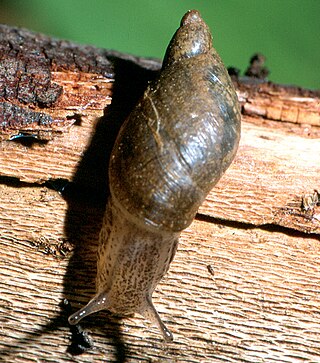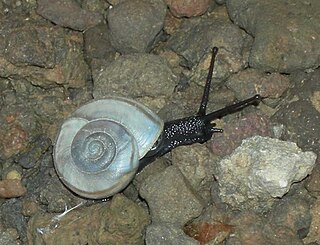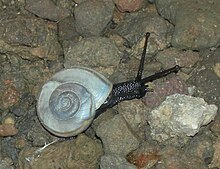
The water pipit is a small passerine bird which breeds in the mountains of Southern Europe and the Palearctic eastwards to China. It is a short-distance migrant; many birds move to lower altitudes or wet open lowlands in winter.

The decollate snail, scientific name Rumina decollata, is a medium-sized predatory land snail, a species of terrestrial pulmonate gastropod mollusk in the family Achatinidae. It is a European species that has been introduced in a number of areas worldwide.

The redear sunfish, also known as the shellcracker, Georgia bream, cherry gill, chinquapin, improved bream, rouge ear sunfish and sun perch) is a freshwater fish in the family Centrarchidae and is native to the southeastern United States. Since it is a popular sport fish, it has been introduced to bodies of water all over North America. It is known for its diet of mollusks and snails.

Heliciculture, commonly known as snail farming, is the process of raising edible land snails, primarily for human consumption or cosmetic use. The meat and snail eggs a.k.a. white caviar can be consumed as escargot and as a type of caviar, respectively.

The Kanab ambersnail, formerly classified as Oxyloma haydeni kanabense or Oxyloma kanabense, is a small, air-breathing land snail belonging to the family Succineidae, the ambersnails. This terrestrial pulmonate gastropod mollusc was previously considered a critically endangered subspecies or species. In 2013, a scientific investigations report by the United States Geological Survey concluded that the Kanab ambersnail is not a genetically distinct species. In June 2021, the Fish and Wildlife Service removed the Kanab ambersnail from the United States Fish and Wildlife Service list of endangered mammals and birds and classified it with other common ambersnails within the same taxa, officially negating its status as a distinct subspecies.

The painted rocksnail is a species of freshwater snail with a gill and an operculum, an aquatic gastropod mollusc in the family Pleuroceridae.
The Grand Wash springsnail is a species of freshwater snail in the family Hydrobiidae, the mud snails. It is endemic to Mohave County, Arizona, in the United States.
The Kingman springsnail is a species of freshwater snail in the family Hydrobiidae, the mud snails. It is endemic to Mohave County, Arizona, in the United States.
The Montezuma Well springsnail is a species of freshwater snail in the family Hydrobiidae, the mud snails. It is endemic to Montezuma Well, a large sinkhole in Yavapai County, Arizona, in the United States.
The Page springsnail is a species of freshwater snail in the family Hydrobiidae, the mud snails. It is endemic to Arizona in the United States, where it is known only from the Upper Verde River drainage in Yavapai County.

Sonorella is a genus of land snails in the subfamily Helminthoglyptinae. They are known commonly as talussnails or talus snails because most live in talus and similar habitat. They are distributed across the southwestern United States and adjacent Mexico. There are about 80 species.
The Franklin Mountain talus snail, scientific name Sonorella metcalfi, is a species of air-breathing land snail, a terrestrial pulmonate gastropod mollusk in the subfamily Helminthoglyptinae. This species is endemic to the United States.

The Chittenango ovate amber snail is a species of small air-breathing land snail in the family Succineidae, the amber snails. This species was discovered in 1905, and was reported three years later as a subspecies of the oval ambersnail, Succinea ovalis. Several taxonomic reviews took place in the subsequent decades until the end of the 1980s, when the Chittenango ovate amber snail was finally judged to be a distinct species based on chemical and morphological data.
The flat-spired three-toothed snail —also known as the Cheat three-toothed snail after the Cheat River in West Virginia—is a species of air-breathing land snail, a terrestrial pulmonate gastropod mollusk in the family Polygyridae.
The Gila tryonia is a species of freshwater snail in the family Hydrobiidae, the mud snails. It is endemic to Arizona in the United States, where it is known only from Graham County.

The Alabama vertigo is a species of land snail in the family Vertiginidae, the whorl snails.

A land snail is any of the numerous species of snail that live on land, as opposed to the sea snails and freshwater snails. Land snail is the common name for terrestrial gastropod mollusks that have shells. However, it is not always easy to say which species are terrestrial, because some are more or less amphibious between land and fresh water, and others are relatively amphibious between land and salt water.

Pyrgulopsis deserta is a species of freshwater snail in the family Hydrobiidae, the mud snails. It is known by the common names desert springsnail, Virgin springsnail, and St. George snail. It occurs in southwestern Utah and northwestern Arizona in the United States.

Sonorella neglecta is a terrestrial pulmonate gastropod mollusc in the subfamily Helminthoglyptinae. Sonorella is a genus of large land snails consisting of over 80 species, with new ones continuing to be described. The shells typically differ only rather subtly, but proportions of the genitalia differentiate species. The genus is distributed in the southwestern USA and northern Mexico, with individual species often restricted to a single mountain massif or to a small part of one. Sonorella neglecta is such a narrow-range endemic from the Chiricahua Mountains. Its official vernacular name is the Portal Talussnail.













